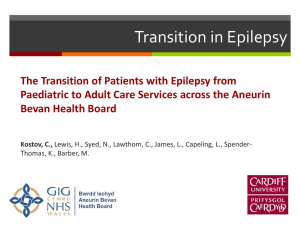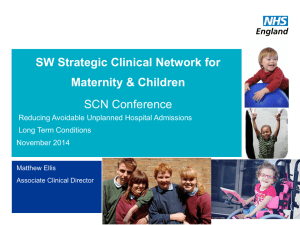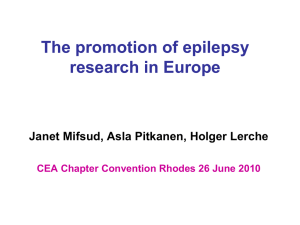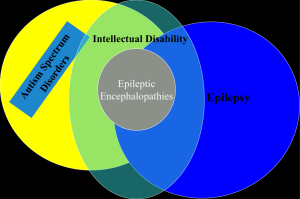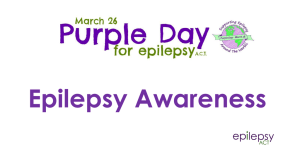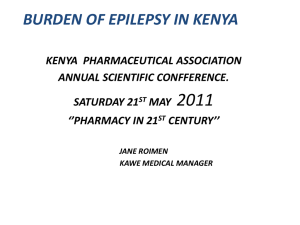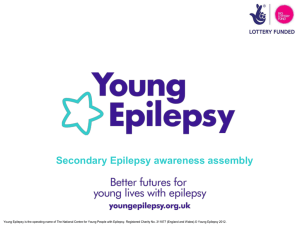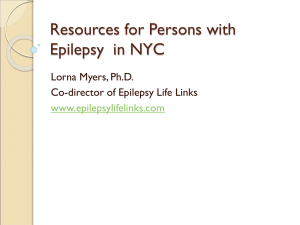Quality standards for Epilepsy
advertisement
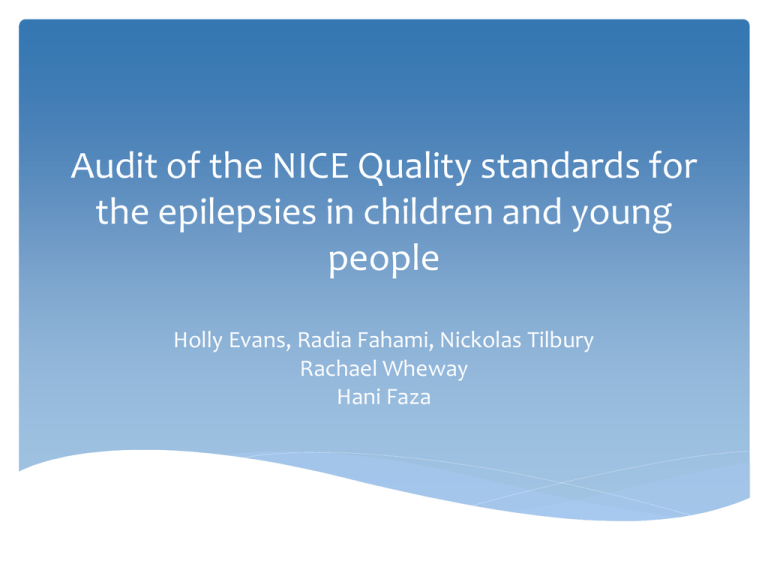
Audit of the NICE Quality standards for the epilepsies in children and young people Holly Evans, Radia Fahami, Nickolas Tilbury Rachael Wheway Hani Faza NICE Quality Standards for the Epilepsies Published Feb 2013 9 standards Define clinical best practice Provide specific quality statements and measures with definition of high-quality care Cover diagnosis and Mx of epilepsy Endorsed by RCPCH, RCGP, ABN, Epilepsy Action and Epilepsy Society NICE Quality Standards for the Epilepsies 1. Children and young people presenting with a suspected seizure are seen by a specialist in the diagnosis and management of the epilepsies within 2 weeks of presentation 2. Children and young people having initial investigations for epilepsy undergo the tests within 4 weeks of them being requested 3. Children and young people who meet the criteria for neuroimaging for epilepsy have MR imaging (57%) 4. Children and young people with epilepsy have an agreed and comprehensive written epilepsy care plan NICE Quality Standards for the Epilepsies 5. Children and young people with epilepsy are seen by epilepsy specialist nurse who they can contact between scheduled reviews 6. Children and young people with a history of prolonged or repeated seizures have an agreed written emergency care plan. 7. Children and young people who meet the criteria for referral to a tertiary care specialist are seen within 4 weeks of referral NICE Quality Standards for the Epilepsies 8. Children with epilepsy have a structured review with a paediatric epilepsy specialist at least annually (89%) 9. Young people with epilepsy have an agreed transition period during which their continuing epilepsy care is reviewed jointly by paediatric and adult services AUDIT Audit of 6 quality standards out of 9 2 out 9 standards: part of Epilepsy 12 audit (round 2) 1 out of 9: to be audited in the future Quality Statement 1 Referral to a Specialist Children and young people presenting with a suspected seizure are seen by a specialist in the diagnosis and management of the epilepsies within 2 weeks of presentation Rationale Diagnosing epilepsy can be complex Misdiagnosis occurs in 5–30% of people. Crucial that specialists involved early in diagnosing epilepsy and that they take great care to establish the correct diagnosis Who is a Specialist? A paediatrician with training and expertise in epilepsy who has for example: Completed the specialist training module on epilepsy developed by RCPCH, or Worked for a min of 6 months in a tertiary centre for neurology in children and attended appropriate paediatric epilepsy training courses. The care of the specialist's patients with epilepsy should be part of an ongoing peer review process related to epilepsy care NICE Quality Standards definition Statement 1 Referral to a Specialist Retrospective review of medical notes of 25 Primary care referrals for suspected epilepsy in children who had an EEG between Jan 2013 and Oct 2013: Time interval between receipt of GP referral and clinic review Paediatrician performing the review Time interval between Referral and Clinic 16 60% Number of patients 14 12 40% 10 8 6 4 2 0 within 2 weeks >2 weeks Number of epilepsy patients seen at clinics 6 5 4 3 2 1 0 HMS RPB JE DMT JMC WDC GJX VPB HNF IAC MAL Epilepsy patients seen by 56% 14 12 44% 10 Number of Patients 8 6 4 2 0 Paediatrician with expertise in Epilepsy General paediatrician Quality Statement 1 Referral to a specialist and seen in 2 weeks 28% Seen by PWEE within 2 weeks Rest 72% Statement 1 Results Summary Paediatricians with expertise in epilepsy are seeing just over 40% of GP referrals for suspected epilepsy 60% of GP referrals for suspected epilepsy are seen within 2 weeks of receipt of referral Only 28% of all GP referrals are seen by PWEE within 2 weeks Statement 1 Recommendation Changes to clinic booking rules to allow more referrals to be seen by PWEE ? Separate pathway for GP referrals (not C&B) Quality Statement 2 Investigations Children and young people having initial investigations for epilepsy undergo the tests within 4 weeks of them being requested Rationale Anxious time for patients and families The earlier a correct diagnosis of epilepsy is made, the sooner tailored therapy can be initiated Statement 2 Investigations (EEG) Audit of every EEG requested and subsequently performed from 01/01/13 to 30/08/13 Data collected: Request date Date performed Type of EEG performed Statement 2 Results 51 EEGs performed 50 were standard EEGs, 1 was 24 hour ambulatory 42 were performed within 4 weeks of request The 9 EEGs that were performed more than 4 weeks from request date were all standard EEGs 6 of the 9 that were performed more than 4 weeks from request date were requested in August EEG results EEG Results Time between date of request and date of EEG 50 82% 40 Number 30 of 20 Patients 10 18% 0 Within >4 4 weeks weeks Statement 2 Results Summary Excellent performance overall Significant amount of EEGs done on the day of request Majority of the 4 week+ delays were in July/August ?busy time for neurophysiology in August Quality Statement 5 Epilepsy Specialist Nurse Children and young people with epilepsy are seen by an epilepsy specialist nurse who they can contact between scheduled reviews. Definition The role ESN is to support both epilepsy specialists and generalists, to ensure access to community and multi agency services and to provide information, training and support to the child, young person or adult, families, carers and others involved in the child's education, welfare and wellbeing Statement 5 Rationale • Epilepsy specialist nurses play a key role in supporting continuity of care between settings for people with epilepsy • There is some evidence that ESN improve clinically important outcomes such as knowledge, anxiety and depression for people with epilepsy in secondary and tertiary care Statement 5 Quality Measures a) Proportion of children and young people with epilepsy who have seen a named epilepsy specialist nurse at diagnosis b) Proportion of children and young people with epilepsy who have seen an epilepsy specialist nurse at their review c) Proportion of children and young people with epilepsy who have the contact details of a named epilepsy specialist nurse Method Patients were identified from an 8 week review of both general and epilepsy clinics This review yielded a total of 79 children identified as having epilepsy 41 were reviewed in epilepsy clinics and 38 were in general clinics Data was then obtained from reviewing clinic letters and notes and from a database held by our ESN. Some patients were also contacted by telephone Results Epilepsy clinics General Clinics Totals No of patients with epilepsy 41 (52%) 38 (48%) 79 New diagnosis since Nov 13 7 1 8 Seen by nurse at diagnosis 4 (57%) 0 4 (50%) Seen by nurse at time of review 33 (80%) 4 (10.5%) 37 (47%) Documentation of nurse presence 17 (41%) 1 (2.6%) 18 (23%) 3 2 5 40 (97%) 24 (63%) 64 (81%) No. seen in nurse-led epilepsy clinic No. with nurse contact details Percentage of patients with epilepsy seen in an epilepsy clinic vs a general clinic A) Percentage of patients seen by an epilepsy specialist nurse at time of diagnosis since November 2013. 100% 90% 80% 43% 70% 60% 50% 100% 40% 30% 57% 20% 10% 0% Diagnosed in epilepsy clinic Diagnosed in general clinic Not Seen by Nurse Specialist Seen by Nurse Specialist B) Percentage of patients seen by an ESN at review 53% 49% 47% 51% Not seen by nurse at review Documented as seen Not documented as seen Percentage of Patients seen by an ENS at review in an epilepsy clinic vs a general clinic Epilepsy clinics 41 Patients 80% General clinics 38 Patients 25% 52% 90% 10% 75% 48% 20% Seen by Nurse at review Documented as seen Not seen by nurse at review C) Percentage of patients across all clinics who have the contact details for the epilepsy specialist nurse Statement 5 Quality Measures Results Summary A) Proportion of children and young people with epilepsy seen by a named ESN at diagnosis 50% B) Proportion of children and young people with epilepsy who have seen an epilepsy specialist nurse at their review (since Nov 2013) 47% (23% documented) C) Proportion of children and young people with epilepsy who have the contact details of a named epilepsy specialist nurse 81% Statement 5 Recommendations More epilepsy nurse time to attend reviews, especially at general paediatric clinics. If patients are attending clinic for their epilepsy, liaise with Epilepsy Nurse regarding her presence at the appointment, where possible. Better documentation in notes/clinic letters regarding the presence of an ESN at review. Audit patient/parent satisfaction with access to ESN Quality Statement 6 Emergency Care Plan Children and young people with a history of prolonged or repeated seizures have an agreed upto-date, written emergency care plan Emergency Care Plan Definition Should describe what happens in event of a prolonged or repeated seizure, including pharmacological treatment that should be given and actions to take, who to contact and when. Agreed between child or young person with epilepsy, their family/carers if appropriate and their primary and secondary healthcare professionals. Training is required to initiate treatment at home or in the community The plan should be reviewed at least annually Method Patients identified from an 8 wk review of general & epilepsy clinics. Data obtained from reviewing ESN database which lists all patients who are prescribed midazolam. ESN also has a folder which holds the most up to date emergency plan for each of these children. Statement 6 Results 79 epilepsy patients were identified. Of these, 24 prescribed rescue medication for prolonged or repeated seizures. 10 patients were reviewed in epilepsy clinics. 14 were seen in general clinics. Bar chart to show percentage of patients with prolonged or repeated seizures and an up to date Emergency Plan Quality Statement 6 Results Summary Children and young people with a history of prolonged or repeated seizures (on rescue medication) have an agreed up to date, written emergency care plan 54% Only 36% of patients attending general paediatric clinics have an agreed up-to-date emergency care plan (vs 80% in those attending epilepsy clinics). Statement 6 Recommendations Patients with prolonged or repeated seizures should have an up-to-date emergency plan reviewed and documented at every review. More epilepsy nurse time is needed to attend reviews and ensure up-to-date emergency care plans. Audit patient/ parent satisfaction with emergency care plans. Quality Statement 7 Tertiary referral Children and young people who meet the criteria for referral to a tertiary care specialist are seen within 4 weeks of referral Rationale Vital for diagnostic uncertainty, specialised advice on drugs, surgery, epilepsy combined with other complicated medical conditions or psychological problems. Timely and appropriate access to tertiary services remains variable across the country Referral Criteria to tertiary services (NICE Guidelines) Referral should be considered when 1 or more of the following criteria are present: 1. Epilepsy not controlled with AED within 2 yrs of onset 2. Management is unsuccessful after 2 drugs 3. The child is under 2 years of age 4. The child or young person experiences, or is at risk of, unacceptable side effects from medication 5. There is a unilateral structural lesion 6.There is psychological or psychiatric comorbidity 7. Diagnostic doubt as to the nature of seizures or seizure syndrome Statement 7 Method Epilepsy patients identified from lists of patients attending paediatric clinics between 4 Feb 2014 and 28 Mar 2014 A total of 67 patients identified 37 out 67 are seen by PWEE 26 out of 67 were candidates for tertiary referral 14 out of those candidates were referred or already under review by paediatric neurologist Clinics attended by epilepsy patients 27% 18 16 22% 14 12 18% Number of 10 Patients 8 10% 6 4 2 0 MAL HNF IAC JMC WDC RPB VPB TST JCS NR HMS JE DMT Proportion of epilepsy patients in paediatric clinics General Paed clinic 22% JMC clinic (neurodisability) PWEE-run clinic 55% Epilepsy patients for tertiary referral Yes 39% No Referral to Tertiary Neurology 16 Number of epilepsy patients 14 12 10 8 54% 6 46% 4 2 0 Referred Not referred Patients not referred to tertiary Uncontrolled after 2 meds, behavioural issues (2 seizures in last yr). Not indicated! Behavioural problems ?ADHD. 1AED. Not indicated! Autism with learning difficulties. 1AED. Not indicated! LD + behavioural problems. 1 AED. Not indicated! <2 yr old.Well controlled on 1 AED. Development-N. Not indicated! Patients not referred to tertiary CP+ ASD. Not seizure free after 2 yrs and one CBZ only ASD + LD. Many DNAs. 1 AED -not seizure-free Not controlled with 2 meds Younger than 2. 1 AED. 5 months since diagnosis Learning difficulties. Rt hemi. Well-controlled- 1 AED severe LD +hypotonia. 1 AED and well controlled LD+ behavioural problems. Multiple AEDs. Now seizure free on 1 Statement 7 Results Summary Just over 50% of candidates for referral to tertiary neurology have been referred. There is some debate as to whether those not referred (5 out of 12) needed a referral. Unable to determine time interval between referral and tertiary neurology clinic in those seen. Statement 7 Recommendation Audit patient or parent/carer satisfaction with referral to tertiary care specialist. Keep a record of date of request for a referral and reaudit. Quality Statement 9 Transition Young people with epilepsy have an agreed transition period during which their continuing epilepsy care is reviewed jointly by paediatric and adult services Definition of period of transition should be a joint clinical action between paediatric and adult services, with at least 1 meeting at a joint consultation and a clear action plan for conducting a review after the young person has transferred into adult services Statement 9 Transition Rationale Important for young people managing the physical and mental transition from adolescence to adulthood. Vital to develop and maintain the self-esteem and confidence of the adolescent with epilepsy. Provides an important opportunity to review the diagnosis, classification, cause and management of a young person's epilepsy before they enter adulthood. Local Set up for epilepsy transition Teenage clinic for patients with epilepsy aged 14 years and above (excludes children with neurodisability) 7 teenage clinics a year (3 MAL, 4HNF)- best practice tariff Adult and paediatric epilepsy nurses present at each clinic Statement 9 Results Reviewed case notes of children 14 years or over 11 out of 67 are 14 years or older 4 out of 11 neurodisability patients and hence excluded All remaining 7 teenagers are seen in Teenage clinics Statement 9 Recommendation Handover clinics with adult neurologist- underway Audit teenage epilepsy patient experience of transition to adult services Summary 28% patients referred for suspected epilepsy seen by PWEE within 2 weeks Majority of EEGs are done within 4 weeks of request 50% of epilepsy patients are seen by ESN at their diagnosis and 47% seen by ESN at their review 54% of patients with epilepsy have an agreed up to date, written emergency care plan (36% in general paed, 80% in epilepsy clinics) Summary More referral to tertiary neurology is needed. There is a need for a handover clinic with an adult neurologist. There are areas for improvement highlighted in this audit. There is a need to re-audit in 2 years following implementation of the proposed recommendations Any questions?
